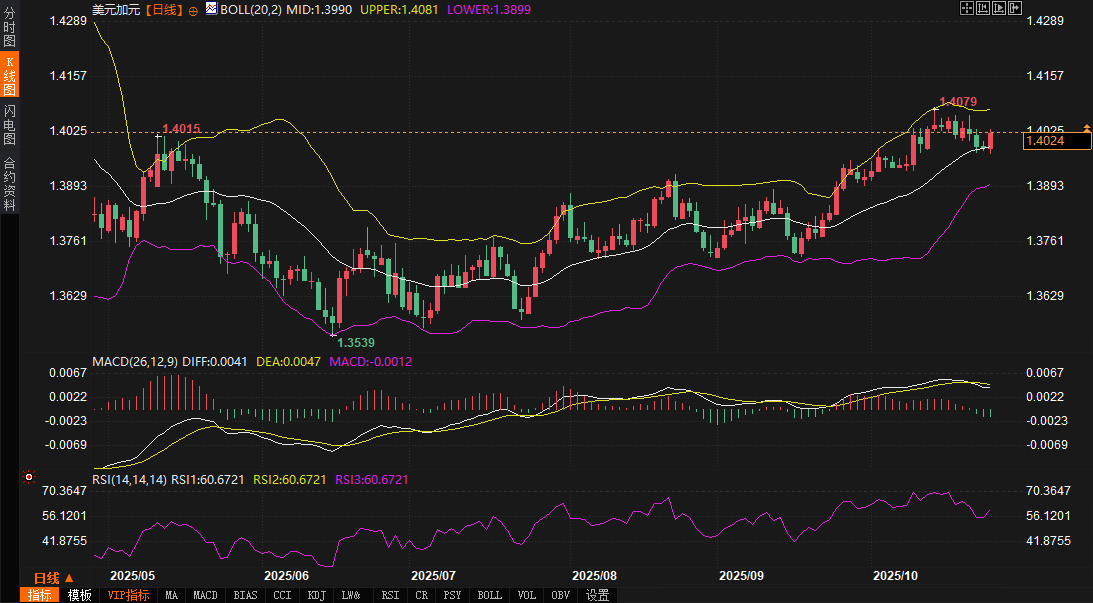Is the Canadian dollar's "judgment day" approaching? Three major contradictions are triggering an exchange rate crisis!
2025-10-24 20:10:42

From a broader perspective, North American foreign exchange markets experienced increased volatility this week, driven both by the Federal Reserve's relatively stable policy path and by multiple pressures facing the Canadian economy. With the unemployment rate remaining stubbornly high at 7.1% and businesses' investment and hiring intentions subdued, these factors have pushed the Canadian dollar to a defensive edge. Some active traders and institutional accounts have noted that recent stronger-than-expected inflation readings are quietly shifting market bets on the central bank's pace of easing. For example, one forex strategist observed that the Canadian dollar briefly strengthened after the data release, but was subsequently squeezed by a rebound in the US dollar, a stark contrast to the overall economic weakness. Another trader noted that higher-than-expected core inflation indicators are forcing policymakers to reassess the pace of easing, providing short-term resilience to the Canadian dollar but also exposing exchange rate vulnerabilities. These frontline responses highlight the market's sensitivity to policy shifts and remind traders to be wary of unexpected news headlines that could disrupt the market.
Fundamental analysis: Expectations of central bank easing dominate, while external uncertainties amplify risks
The Bank of Canada's upcoming policy decision on October 29th is attracting much attention. Most economists expect the central bank to cut its overnight rate by another 25 basis points to 2.25%, marking its second consecutive rate cut. As early as last month, the central bank had already implemented a cumulative 250 basis points of easing, among the largest among G10 countries. This round of easing is intended to inject momentum into the sluggish economy, close the output gap, and gradually ease unemployment pressures. A survey of economists from a leading institution showed that 23 respondents, nearly 70%, were optimistic about the proposed rate cut. Only a minority remained cautious, suggesting a wait-and-see approach until December. Institutional commentary echoed this consensus, with one macroeconomic analyst stating in a post that "the priority remains to boost economic momentum and help bring unemployment down." This aligns with the central bank governor's recent statements, which emphasize a greater focus on weighing potential risks.
The core of this expectation lies in the sluggish economic fundamentals. Canada's GDP contracted by an annualized 1.6% last quarter, with exports bearing the brunt of the risk aversion triggered by US tariff rhetoric. Exports of key categories such as steel, aluminum, and automobiles came under pressure, and the sudden interruption of trade negotiations further dampened business confidence. Although the United States-Mexico-Canada Agreement (USMCA) faces a review period next year, the continuation of the current exemption mechanism has become a market concern. Economists from well-known institutions warned that if negotiations fail to extend the agreement framework, tariff risks may amplify downward pressure on the economy, leading to the need to restart the easing cycle in 2026. A member of the trading community shared: "The echoes of trade frictions are making the Canadian dollar tread on thin ice. Although the central bank's easing is a buffer, external variables dominate the exchange rate narrative."
Meanwhile, inflation dynamics complicate decision-making. Last month, the CPI rose to 2.4%, accelerating from 1.9% in August, with core indicators also exceeding expectations. While this remains within the central bank's target range of 1%-3%, it has left some economists cautious about further rate cuts. In a survey, 21 experts predicted the overnight rate would remain at 2.25% until the end of next year, right at the lower end of the central bank's neutral range, neither stimulating nor suppressing activity. Only a minority are betting on a rate below 2%, citing inflationary stickiness and the potential for increased fiscal support—the federal budget in early November may inject additional stimulus. An RBC economist noted in a recent interview: "There is limited room to exceed 2.25%. Recalcitrant inflation coupled with fiscal expansion will test the central bank's balancing act." Traders say, "The hot CPI data has dashed the illusion of multiple rate cuts by the end of the year. The Canadian dollar may find some short-term respite, but the long-term outlook remains dependent on policy."
The economic growth outlook is equally bleak. The median poll forecast suggests GDP rebounded by 0.5% annualized last quarter and is expected to expand by 0.9% this quarter, averaging just 1.2% for the full year and next year, a further downward revision from the 1.3% forecast in July and the lowest level since the pandemic. The unemployment rate is expected to hover around 7.1% until the second half of next year, with consumption and investment recovering slowly. These indicators collectively reinforce the need for easing, but also highlight the structural weakness of the Canadian dollar's dependence on policy. Traders should note that external factors, such as the aftermath of the Russia-Ukraine situation, are indirectly transmitting to Canadian exports through energy and commodities, amplifying exchange rate fluctuations.
Technical analysis: Momentum gradually diverges amidst volatile upward movement
Turning to the technical side of the market, the USD/CAD daily chart shows a typical upward oscillating pattern, favoring a short-term bullish trend but accompanied by divergent signals. The Bollinger Bands (20, 2) indicator shows the middle band at 1.3990, the upper band at 1.4081, and the lower band at 1.3899. The price is currently trading close to the upper mid-range, suggesting that upward momentum has not yet been exhausted, but the upper band pressure has become a key test. The recent rebound from the lower band at 1.3899 has been clear, with a cumulative increase of over 130 points, reflecting the continued pressure from the strong US dollar on the Canadian dollar.
The MACD (12, 26, 9) indicators further support this trend: the DIFF line is at 0.0041, and the DEA line is at 0.0047. Both are in positive territory, but the DIFF line is slightly lower than the DEA line, indicating that the histogram momentum is converging. This suggests that the short-term bullish advance may encounter resistance, and the risk of a potential correction is increasing, especially if the price retests the middle line at 1.3990. In comparing historical highs and lows, the current level has moved away from the previous trough (around 1.3899), but there is still room to reach the year's peak. Traders often use this as a dividing line between long and short positions.

In terms of trading volume, with the stabilization of the US dollar index this week, short positions in the Canadian dollar have accumulated significantly, and the market consensus indicates that speculators are net-short on the CAD. Regarding support, the 1.3990 mid-line coincides with the previous low, forming the first line of defense. A break above the 1.4081 upper line could test the monthly high. Overall, technical analysis reinforces the fundamental narrative: the Canadian dollar is under pressure due to easing expectations, but resilient inflation may provide a respite. Traders should be wary of unexpected news events that could disrupt indicators. If the central bank's statement exceeds expectations, volatility will be amplified.
Outlook: Exchange rate path stabilizes under policy anchoring, but caution against external factors
Looking ahead to next week and beyond, the Bank of Canada's policy path is expected to remain anchored in the neutral range of 2.25%, with little prospect of radical adjustments in the near term. This will provide a relatively stable support framework for the Canadian dollar. While economic growth is sluggish, a potential rebound in Q4 and fiscal buffers may mitigate downward pressure. If inflation remains within the target, exchange rate fluctuations will tend to converge. USD/CAD is likely to fluctuate between 1.3950 and 1.4080. If the US dollar's strength continues, it will maintain moderate upward pressure on the Canadian dollar. However, the progress of trade negotiations will be a turning point. If the aftermath of tariff rhetoric subsides, the Canadian dollar will have room to rebound.
In the long term, the outlook for interest rates in 2026 depends on the external environment. If the USMCA review goes smoothly, the central bank may pause its easing policy and shift its focus to monitoring employment and growth. Conversely, trade uncertainty could reignite expectations of rate cuts, pushing USD/CAD to new highs. Traders are increasingly unanimous: the Canadian dollar's resilience stems from policy buffers, but external friction remains a "black swan" for the exchange rate.
- Risk Warning and Disclaimer
- The market involves risk, and trading may not be suitable for all investors. This article is for reference only and does not constitute personal investment advice, nor does it take into account certain users’ specific investment objectives, financial situation, or other needs. Any investment decisions made based on this information are at your own risk.





















